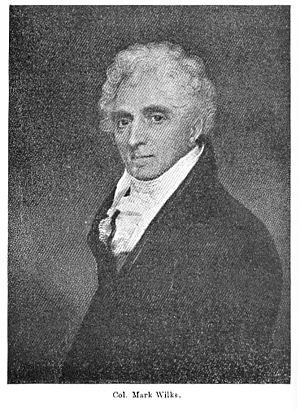Mark Wilks facts for kids
Colonel Mark Wilks (born 1759, died 1831) was a soldier, historian, and administrator from the Isle of Man. He worked for the East India Company in southern India, especially in the princely state of Mysore. He was like a special representative (called a Resident) at the Wodeyar Court there.
Early Life and Career
Mark Wilks was born in Kirk Michael on the Isle of Man. His father was a reverend, and his family had a long history on the island. He was named after his godfather, Bishop Mark Hiddesley.
In 1781, when he was 18, Mark joined the Madras Army, which was part of the East India Company. He became an officer in 1782. Like other officers, he trained at Fort St. George and learned the Persian language. He even translated a Persian poem called Aklak-i-Naseri into English.
Mark Wilks worked as a secretary for the Military Board in 1787. He went with Sir Barry Close on an important diplomatic trip to Mysore. He had studied Greek and Latin classics when he was young. Later, he encouraged his nephew, Mark Cubbon, to study them too. Around 1788, he was the Town Major at Fort Saint George, which was the capital of Madras Presidency.
After a break in England, Wilks became a private secretary to Lord Edward Clive. He also served with General James Stuart during the attack on Srirangapatna in May 1799. This battle led to the death of Tipu Sultan. In 1803, he returned to India and became the Resident (a special representative) in Mysore.
Historian and Author
Mark Wilks wrote several important history books. One was called Report on the Internal Administration of Mysore. This book continued a survey of the Kingdom of Mysore started by Lieut. Col. Colin Mackenzie.
He also wrote Historical Sketches of the South of India in an attempt to trace the History of Mysoor. This book also used information from Lieut. Col. Colin Mackenzie's work. Mark Wilks was the uncle of Mark Cubbon, who later became the Commissioner of Mysore. Cubbon Park in Bangalore is named after his nephew.
After returning from India, Mark Wilks worked with James Achilles Kirkpatrick to write one of the first histories of medieval South India. This book, Historical Sketches of the South of India, looked at how the Mysore Wodeyar family rose to power after the fall of Vijayanagara in 1565. Wilks wrote about the rule of Haidar Ali and Tipu Sultan in his historical studies. He also tried to understand why the Vijaynagar Empire declined.
Governor of Saint Helena
In 1813, Mark Wilks was appointed Governor of Saint Helena for three years. This island was where the former French Emperor Napoleon was exiled. Napoleon reportedly found Wilks to be a very interesting and friendly person.
Saint Helena was a place involved in the slave trade. As Governor, Wilks did not stop it, but he showed sympathy for a freed slave named Samuel Ally. Wilks also invited William Roxburgh to study if a plant called cinchona could be grown on the island.
After the British government temporarily took control of St Helena from the East India Company during Napoleon's time there, Wilks returned to England in 1816. He was elected to the Manx parliament, known as the House of Keys. In 1826, after his father-in-law passed away, he became the Speaker of the House. A portrait of Mark Wilks can still be seen in the Tynwald building in Douglas.
Later Life and Family
In February 1826, Colonel Mark Wilks was elected a Fellow of the Royal Society. This is a very respected group for scientists and thinkers.
He was married twice. In 1813, he married his second wife, Dorothy Taubman. She was the daughter of the previous Speaker of the House of Keys. He had a son named John Barry, who died young, and a daughter named Laura. Laura married General Sir John Buchan. Mark Wilks died in 1839 while visiting his daughter's home in Scotland.
Sir Mark Wilks Collet, 1st Baronet was his great-great nephew. Their historical papers are kept together at the Manx National Heritage Library and Archives.


